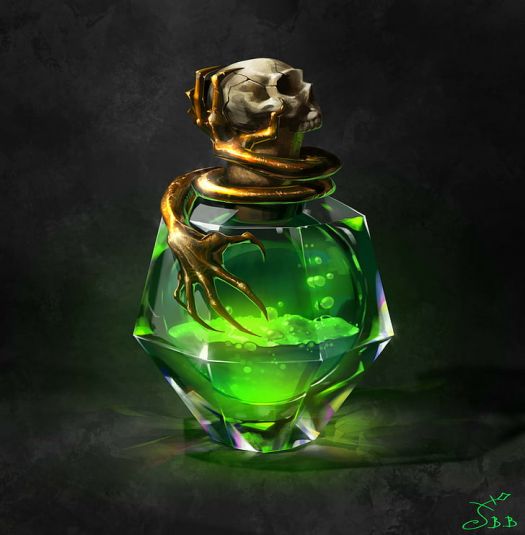Difference between revisions of "Ingestive Poisons"
Tao alexis (talk | contribs) |
Tao alexis (talk | contribs) |
||
| Line 1: | Line 1: | ||
| − | '''Ingestive Poisons''' are | + | [[File:Ingestive Poison.jpg|right|525px|thumb]] |
| + | '''Ingestive [[Poison (substance)|Poisons]]''' are introduced into the body by consuming the elixir, unlike [[Insinuative Poison|insinuative poisons]] that must be introduced through a cut in the skin. The effects vary, depending on the [[Prepare Ingestive Poisons (sage ability)|poisoner's]] intent. Certainly, however, every poison means to bring harm to whomever imbibes the intended potion. The art of introducing poison into a victim's food or drink is called "[[Dosing (sage ability)|dosing]]." | ||
| + | |||
| + | == Examples == | ||
| + | The four most common ingestive poisons are '''[[Prepare_Ingestive_Poisons_(sage_ability)#Biliosus|biliosus]]''', '''[[Prepare_Ingestive_Poisons_(sage_ability)#Ictus|ictus]]''', '''[[Prepare_Ingestive_Poisons_(sage_ability)#Somnikus|somnikus]]''' and '''[[Prepare_Ingestive_Poisons_(sage_ability)#Vexation|vexation]]'''. Any amateur poison-maker can create these tinctures, though they require a laboratory and four to six days to "compound," or mix together so as to be effective and difficult to detect for the unwary and inexperience victim. | ||
| + | |||
| + | Biliosus is made from herbs and produces an intense [[Nausea|nausea]] which weakens in order to incapacitate. Ictus is derived from fruit-seed and produces a partial [[Paralysation|paralysis]]. Somnikus is an extract from narcotic plants that cause the victim to fall asleep. Vexation uses a solution from mushrooms in order to kill. Each has specific effects that are outlined in the links above. | ||
| + | |||
| + | == Detection == | ||
___ EDIT LINE ___<br> | ___ EDIT LINE ___<br> | ||
| − | |||
| − | + | ||
The chance of detecting an ingestive poison before it is consumed is equal to 60%, minus the [[Knowledge Points|knowledge]] of the preparer. Thus, a dose created by an amateur with 11 knowledge points would be detected in [[Food|food]] or drink with a 49% chance, from its odour, surface oiliness or due to discoloration of the food. | The chance of detecting an ingestive poison before it is consumed is equal to 60%, minus the [[Knowledge Points|knowledge]] of the preparer. Thus, a dose created by an amateur with 11 knowledge points would be detected in [[Food|food]] or drink with a 49% chance, from its odour, surface oiliness or due to discoloration of the food. | ||
Amateur-created poisons, once consumed, will suggest that something is wrong immediately; within 1-3 rounds, the imbiber will know that the poisoning has occurred, as the first effects take place. | Amateur-created poisons, once consumed, will suggest that something is wrong immediately; within 1-3 rounds, the imbiber will know that the poisoning has occurred, as the first effects take place. | ||
Revision as of 01:33, 10 May 2022
Ingestive Poisons are introduced into the body by consuming the elixir, unlike insinuative poisons that must be introduced through a cut in the skin. The effects vary, depending on the poisoner's intent. Certainly, however, every poison means to bring harm to whomever imbibes the intended potion. The art of introducing poison into a victim's food or drink is called "dosing."
Examples
The four most common ingestive poisons are biliosus, ictus, somnikus and vexation. Any amateur poison-maker can create these tinctures, though they require a laboratory and four to six days to "compound," or mix together so as to be effective and difficult to detect for the unwary and inexperience victim.
Biliosus is made from herbs and produces an intense nausea which weakens in order to incapacitate. Ictus is derived from fruit-seed and produces a partial paralysis. Somnikus is an extract from narcotic plants that cause the victim to fall asleep. Vexation uses a solution from mushrooms in order to kill. Each has specific effects that are outlined in the links above.
Detection
___ EDIT LINE ___
The chance of detecting an ingestive poison before it is consumed is equal to 60%, minus the knowledge of the preparer. Thus, a dose created by an amateur with 11 knowledge points would be detected in food or drink with a 49% chance, from its odour, surface oiliness or due to discoloration of the food.
Amateur-created poisons, once consumed, will suggest that something is wrong immediately; within 1-3 rounds, the imbiber will know that the poisoning has occurred, as the first effects take place.
